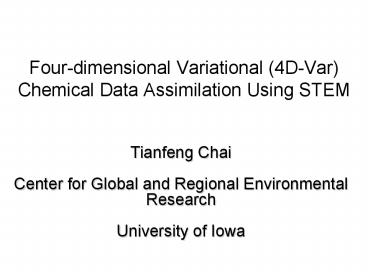Fourdimensional Variational 4DVar Chemical Data Assimilation Using STEM - PowerPoint PPT Presentation
1 / 44
Title:
Fourdimensional Variational 4DVar Chemical Data Assimilation Using STEM
Description:
Four-dimensional Variational (4D-Var) Chemical Data Assimilation Using ... Quantile-quantile measurements and model results. Ron-Brown ozone and model results ... – PowerPoint PPT presentation
Number of Views:66
Avg rating:3.0/5.0
Title: Fourdimensional Variational 4DVar Chemical Data Assimilation Using STEM
1
Four-dimensional Variational (4D-Var) Chemical
Data Assimilation Using STEM
Tianfeng Chai Center for Global and Regional
Environmental Research University of Iowa
2
Outline
- Introduction to 4D-Var data assimilation
- Early applications using Trace-P data
- Target-oriented adjoint sensitivity analysis
- New development for ICARTT data
- Model background error statistics
- 4D-Var Implementation of background error
statistics using TSVD - Top-down emission inversion
3
Data assimilation Model Observation
To understand and/or forecast air pollution, we
need
- Measurements, samplings of the reality
- Chemical Transport Models (CTMs), describing the
physical and chemical processes - Data assimilation techniques, optimally integrate
models and observations - Background (a priori) error statistics
- Observation error statistics
- Model error information
4
Data assimilation
(new)
dx
(old forecast)
5
Challenges in chemical data assimilation
- A large amount of variables (100 concentrations
of various species at each grid points) - Memory shortage (check-pointing required)
- Various chemical reactions (gt200) coupled
together (lifetimes of species vary from seconds
to months) - Stiff differential equations
- Chemical observations are very limited, compared
to meteorological data - Information should be maximally used, with least
approximation - Highly uncertain emission inventories
- Inventories often out-dated, and uncertainty not
well-quantified
6
Computational aspects
- Parallel Implementation using our PAQMSG library
- The parallel adjoint STEM implements a
distributed checkpointing scheme
7
Chemical Transport Model
- 3D atmospheric transport-chemistry model
(STEM-III)
where chemical reactions are modeled by
nonlinear stiff terms
- Use operator splitting to solve CTM
8
Basic idea of 4D-Var
- Define a cost functional
which measures the distance between model output
and observations, as well as the deviation of the
solution from the background state
- Derive adjoint of tangent linear model
Where fis the forcing term, which is chosen so
that the adjoint variables are the sensitivities
of the cost functional with respect to state
variables (concentrations), i.e.
- Use adjoint variables for sensitivity analysis,
as well as data assimilation
9
4D-Var application with CTMs
10
Trace-P DC-8 and P3-B flights on 3/7/2001
- Simulated region East Asia
- Simulated time interval 12 hours (starting at
00000 GMT 3/7/01) - Meteorological fields given by RAMS
- Grid size 90 60 18
- Horizontal resolution 80 Km 80 Km
- Control parameters initial concentration
- Optimization algorithm L-BFGS-B
11
DC-8 O3 observations and model predictions
12
Effect on P3-B O3 model predictions
13
Adjoint sensitivity analysis
Direct sensitivity analysis is a source-oriented
approach.
Adjoint sensitivity analysis is a
receptor/target-oriented approach.
14
Influence functions (over Cheju O3 concentration
at 0000 UT, 3/07/01) of O3, NO2, HCHO at -48,
-24 hr
15
Sensitivity Analysis
Adjoint sensitivities identify key species
affecting model predictions (NOy of P3-B).
16
Selecting control variables
17
NO and NO2 predictions after assimilating NOy
18
Cone of influence Target 1600 GMT 8/6/04
19
ICARTT
International Consortium for Atmospheric Research
on Transport and Transformation of Pollutants
20
Observational error
- Observational Error
- Representative error
- Measurement error
- Observation Inputs
- Averaging inside 4-D grid cells
- Uniform error (8 ppbv)
21
Air Quality Forecasts for NMC method
22
NMC method
- Substitute model background errors with the
differences between 24hr, 48 hr, 72 hr forecasts
verifying at the same time - Calculate the model background error statistics
in three directions separately
- Equivalent sample number 811,890
23
NMC method results
- Equivalent sample number 360,840
24
NMC method results
Vertical correlation
Horizontal correlation
25
Observational (Hollingsworth-Lönnberg) method
results
i
j
Rij
26
Implementation using TSVD
27
Vertical correlation of model errors, Z (left)
and Zq (Right, after TSVD truncation).
28
Assimilated observations
29
RMS error changes of model predictions
30
DC-8 Ozone and model results
31
P3 Ozone measurements and model results
Quantile-quantile measurements and model results
32
Ron-Brown ozone and model results
33
Assimilating satellite data
We are now assimilating MODIS (AOD), MOPITT
(CO), SCIAMACHY (column NO2) to constrain model
and estimate emission
Terra
http//www-misr.jpl.nasa.gov/
- Satellite data
- Global coverage
- Year-round operation
http//eosweb.larc.nasa.gov
34
STEM SCIAMACHY tropospheric NO2 column
35
Mean SCIAMACHY tropospheric NO2 column in
July-August,2004
36
STD/Mean of tropospheric NO2 column
37
NOx emission scaling factor
38
Summary and future work
- 4D-Var data assimilation system developed for
STEM is able to assimilate chemical observations
into CTM - generate better reanalysis
- target-oriented sensitivity analysis
- Top-down emission estimation
- Background model error has been analyzed using
NMC and observational approaches. - The utilization of the model error statistics in
chemical data assimilation through TSVD improves
model analysis and air quality forecasting. - Adjusting initial concentration and emission
inventories simultaneously in assimilation is
being tested
This work is supported by NSF, NASA, and NOAA
grants
39
Thank you!
40
Introduction
- Understanding model uncertainty is crucial in
chemical data assimilation - Model uncertainties are studied using STEM
forecasts during ICARTT - Model error correlation covariance through NMC
approach - Model error variance through observational
approach - This information is then utilized in 4D-Var
chemical data assimilation experiments - Truncated Singular Value Decomposition used to
solve ill-conditioning - Validation is performed by withholding
independent observations from the data
assimilation tests. The effect of such chemical
data assimilation on improving air quality
forecasts is also evaluated.
41
Sensitivities
O3
CO
NO2
42
Assimilating multiple species
Measurement uncertainties O3 8 NO
20 NO2 20 HNO3 100 PAN 100 RNO3 100
43
Assimilating multiple species
(In lower panels, green lines shows the effect of
more iterations)
44
Predictability as Measured by Correlation
Coefficient Met Parameters are Best
lt 1km
O3 predicted better than CO
Performance decreases with altitude
Carmichael et al., JGR, 2003































